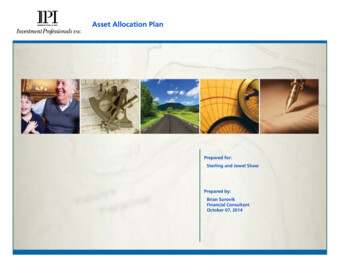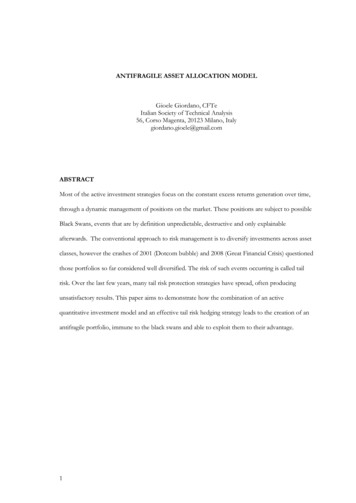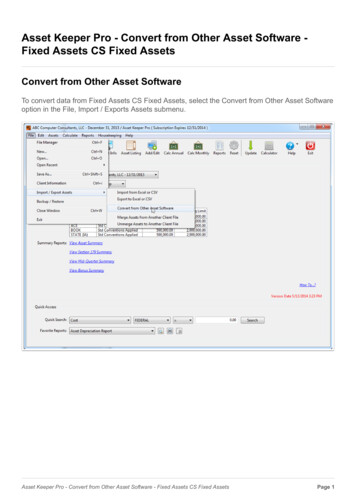
Transcription
Asset Allocation PlanPrepared for:Sterling and Jewel ShawPrepared by:Brian SurovikFinancial ConsultantOctober 07, 2014
Table Of ContentsIMPORTANT DISCLOSURE INFORMATIONResults ComparisonTarget BandPortfolio DetailDistribution and Reallocation by Asset ClassRisk Assessment1-7891011 - 1213
IMPORTANT DISCLOSURE INFORMATIONIMPORTANT: The projections or other information generated by MoneyGuidePro regardingthe likelihood of various investment outcomes are hypothetical in nature, do not reflectactual investment results, and are not guarantees of future results.The return assumptions in MoneyGuidePro are not reflective of any specific product, and donot include any fees or expenses that may be incurred by investing in specific products. Theactual returns of a specific product may be more or less than the returns used inMoneyGuidePro. It is not possible to directly invest in an index. Financial forecasts, rates ofreturn, risk, inflation, and other assumptions may be used as the basis for illustrations. Theyshould not be considered a guarantee of future performance or a guarantee of achievingoverall financial objectives. Past performance is not a guarantee or a predictor of futureresults of either the indices or any particular investment.MoneyGuidePro results may vary with each use and over time.Not FDIC InsuredNo Bank or Credit Union GuaranteeMay Lose ValueMoneyGuidePro Assumptions and LimitationsInformation Provided by YouInformation that you provided about your assets, risk tolerance, and personal situation arekey assumptions for the calculations and projections in this Report. Please review theReport sections titled “Results Comparison,” “Risk Questionnaire,” and the last page of“Monte Carlo Results” to verify the accuracy of these assumptions. If any of theassumptions are incorrect, you should notify your financial advisor. Even small changes inassumptions can have a substantial impact on the results shown in this Report. Theinformation provided by you should be reviewed periodically and updated when either theinformation or your circumstances change.All asset and net worth information included in this Report was provided by you or yourdesignated agents, and is not a substitute for the information contained in the officialaccount statements provided to you by custodians. The current asset data and valuescontained in those account statements should be used to update the asset informationincluded in this Report, as necessary.Assumptions and LimitationsAll results in this Report are hypothetical in nature, do not reflect actual investment results,and are not guarantees of future results. All results use simplifying assumptions that do notcompletely or accurately reflect your specific circumstances. No Plan or Report has theability to accurately predict the future. As investment returns, inflation, taxes, and othereconomic conditions vary from the MoneyGuidePro assumptions, your actual results willvary (perhaps significantly) from those presented in this Report.All MoneyGuidePro calculations use asset class returns, not returns of actual investments.The average annual historical returns are calculated using the indices contained in thisReport, which serve as proxies for their respective asset classes. The index data are for theperiod 1970 - 2013. The portfolio returns are calculated by weighting individual returnassumptions for each asset class according to your portfolio allocation. The portfolio returnsmay have been modified by including adjustments to the total return and the inflation rate.The portfolio returns assume reinvestment of interest and dividends at net asset valuewithout taxes, and also assume that the portfolio has been rebalanced to reflect the initialrecommendation. No portfolio rebalancing costs, including taxes, if applicable, arededucted from the portfolio value. No portfolio allocation eliminates risk or guaranteesinvestment results.MoneyGuidePro does not provide recommendations for any products or securities.Prepared for : Sterling and Jewel Shaw10/07/2014Company Name : IPIPrepared by: Brian SurovikPage 1 of 13
IMPORTANT DISCLOSURE INFORMATIONAsset ClassHistorical Return IndexCash & Cash AlternativesIbbotson U.S. Treasury Bills - Total Return (1926-2013)Cash & Cash Alternatives (Tax-Free)U.S. 30-Day Treasury Bill adjusted by Donoghue TF discount (1970-1981)Tax-Free Money Market Average (1982-2013)50% Ibbotson U.S. Treasury Bills and 50% Ibbotson Intermediate-Term GovernmentBonds (1970-1978)BofA Merrill Lynch 1-3 Year Govt Bonds (1979-2013)50% Ibbotson U.S. T-Bill and 50% Ibbotson Intermediate-Term Government Bondsadjusted by Barclays Capital 3-year Muni discount (1970-1990)Barclays Capital 3-year Muni Bonds (1991-2013)Short Term BondsShort Term Bonds (Tax-Free)Intermediate Term BondsIbbotson Intermediate-Term Government Bonds - Total Return (1926-2013)Intermediate Term Bonds (Tax-Free)Ibbotson Long-Term Government Bonds - Total Return adjusted by Barclays Capital10-year Muni discount (1970-1979)Barclays Capital 10-year Muni Bonds (1980-2013)Long Term BondsIbbotson Long-Term Corporate Bonds - Total Return (1926-2013)Long Term Bonds (Tax-Free)Ibbotson Long-Term Government Bonds - Total Return adjusted by Barclays Capital LongMuni Bonds discount (1970-1980)Barclays Capital Long Muni Bonds (1981-2013)S&P 500 Composite Total Return (1970-1994)S&P 500 Value Total Return(1995-2013)S&P 500 Composite Total Return (1970-1994)S&P 500 Growth Total Return (1995-2013)S&P 500 Composite Total Return (1970-1979)Russell Midcap (1980-2013)Large Cap Value StocksLarge Cap Growth StocksMidcap StocksSmall Cap StocksIbbotson Small Company Stocks - Total Return (1926-2013)International Developed StocksMSCI EAFE Equity (1970-2013)International Emerging StocksMSCI EAFE Equity (1970-1975)IFC Global Emerging Markets Index (1976-1987)MSCI EM (Emerging Markets) (1988-2013)Dow Jones Wilshire REIT Mean Return (1970-1977)Dow Jones Wilshire REIT (Full Cap) (1978-2013)REITPrepared for : Sterling and Jewel Shaw10/07/2014Company Name : IPIPrepared by: Brian SurovikPage 2 of 13
IMPORTANT DISCLOSURE INFORMATIONRisks Inherent in InvestingMoneyGuidePro MethodologyInvesting in fixed income securities involves interest rate risk, credit risk, and inflation risk.Interest rate risk is the possibility that bond prices will decrease because of an interest rateincrease. When interest rates rise, bond prices and the values of fixed income securities fall.When interest rates fall, bond prices and the values of fixed income securities rise. Creditrisk is the risk that a company will not be able to pay its debts, including the interest on itsbonds. Inflation risk is the possibility that the interest paid on an investment in bonds willbe lower than the inflation rate, decreasing purchasing power.Monte Carlo SimulationsCash alternatives typically include money market securities and U.S. treasury bills. Investingin such cash alternatives involves inflation risk. In addition, investments in money marketsecurities may involve credit risk and a risk of principal loss. Because money marketsecurities are neither insured nor guaranteed by the Federal Deposit Insurance Corporationor any other government agency, there is no guarantee the value of your investment will bemaintained at 1.00 per share. U.S. Treasury bills are subject to market risk if sold prior tomaturity. Market risk is the possibility that the value, when sold, might be less than thepurchase price.Investing in stock securities involves volatility risk, market risk, business risk, and industryrisk. The prices of most stocks fluctuate. Volatility risk is the chance that the value of a stockwill fall. Market risk is chance that the prices of all stocks will fall due to conditions in theeconomic environment. Business risk is the chance that a specific company’s stock will fallbecause of issues affecting it. Industry risk is the chance that a set of factors particular to anindustry group will adversely affect stock prices within the industry. (See “Asset Class –Stocks” in the Glossary section of this Important Disclosure Information for a summary ofthe relative potential volatility of different types of stocks.)International investing involves additional risks including, but not limited to, changes incurrency exchange rates, differences in accounting and taxation policies, and political oreconomic instabilities that can increase or decrease returns.Report Is a Snapshot and Does Not Provide Legal, Tax, or Accounting AdviceThis Report provides a snapshot of your current financial position and can help you to focuson a possible Asset Allocation strategy, and to create a plan of action. Because the resultsare calculated over many years, small changes can create large differences in future results.You should use this Report to help you focus on the factors that are most important to you.This Report does not provide legal, tax, or accounting advice. Before making decisions withlegal, tax, or accounting ramifications, you should consult appropriate professionals foradvice that is specific to your situation.Prepared for : Sterling and Jewel Shaw10/07/2014Monte Carlo simulations are used to show how variations in rates of return each year canaffect your results. A Monte Carlo simulation calculates the results of your Plan by runningit many times, each time using a different sequence of returns. Some sequences of returnswill give you better results, and some will give you worse results. These multiple trialsprovide a range of possible results. Monte Carlo Simulations illustrate the likelihood that anevent may occur as well as the likelihood that it may not occur. In analyzing thisinformation, please note that the analysis does not take into account actual marketconditions, which may severely affect the outcome of the results over the long-term.In the Monte Carlo simulation in an Asset Allocation Plan, MoneyGuidePro runs 1,000separate scenarios of your Plan, using the information you entered, while varying thesequence of returns and inflation rates. To create the sequences of returns and inflationrates, MoneyGuidePro starts with the average returns and standard deviations for theportfolio and for inflation. If you are using historical returns, the return, inflation rate, andstandard deviations are calculated based on the time period you have selected. If you areusing projected returns, the return, inflation rate, and standard deviations are as indicatedby you. Standard deviation is a statistical measure of volatility, and indicates how much atypical sequence of portfolio returns (or inflation rates) may vary from the average. A smallstandard deviation indicates that the returns (or inflation rates) over a period of time willtypically be closer to the average than returns or inflation rates with a larger standarddeviation.For each scenario, MoneyGuidePro creates a random sequence of returns and a randomsequence of inflation rates (using the average return and standard deviation as guidelinesfor a range of returns, and the average inflation and standard deviation as guidelines for therange of inflation rates), which it uses to calculate the results for that scenario. Eachscenario has a different sequence of returns and inflation rates.In an Asset Allocation Plan, you can select a Monte Carlo Simulation for an accumulationperiod, or for an accumulation period followed by a distribution period. When you selectonly an accumulation period, MoneyGuidePro calculates, using the assumptions you haveprovided, a range for the amount of money that you could accumulate in the periodspecified.Company Name : IPIPrepared by: Brian SurovikPage 3 of 13
IMPORTANT DISCLOSURE INFORMATIONWhen you select an accumulation period followed by a distribution period, in addition toproviding a range for the amount of money you could have at the end of the periodspecified, MoneyGuidePro also tabulates whether each scenario is successful orunsuccessful. A scenario is counted as successful if you can withdraw the amount specifiedfor the total number of years in the distribution period. A scenario is counted asunsuccessful if the portfolio is depleted prior to the end of the distribution period. Thepercentage of successful scenarios is shown as the “Likelihood your money could last” forthe number of years specified. The highest calculated likelihood that your money could lastuntil the end of the distribution period is 99%. Even a likelihood of 99% does notconstitute a guarantee that the outcome will be as projected, because the results presentedare based on multiple assumptions, each of which is subject to change as a result of marketvolatility, economic factors and world events.MoneyGuidePro Presentation of ResultsRange of Possible Results ChartMoneyGuidePro takes the 1,000 Results from the 1,000 scenarios, and puts them in orderfrom highest to lowest, based on the ending portfolio value. The range of these Results isusually very wide. Rather than showing all 1,000 Results, the Chart shows the Results ofthree of the scenarios that provide a summary of the range of Results from this simulation.The Results are shown in both Current Dollars and Future Dollars.Remember that each scenario had a different sequence of randomly generated returns andinflation rates. While each scenario is a possible outcome, there are other possibleoutcomes that are not shown. These scenarios illustrate a range of possible returns usingthe assumptions you specified.MoneyGuidePro Risk AssessmentThe MoneyGuidePro Risk Assessment highlights some – but not all – of the trade-offs youmight consider when deciding how to invest your money. This approach does not provide acomprehensive, psychometrically-based, or scientifically-validated profile of your risktolerance, loss tolerance, or risk capacity, and is provided for informational purposes only.Based on your specific circumstances, you must decide the appropriate balance betweenpotential risks and potential returns.
Short Term Bonds 50% Ibbotson U.S. Treasury Bills and 50% Ibbotson Intermediate-Term Government Bonds (1970-1978) BofA Merrill Lynch 1-3 Year Govt Bonds (1979-2013) Short Term Bonds (Tax-Free) 50% Ibbotson U.S. T-Bill and 50% Ibbotson Intermediate-Term Government Bonds adjusted by Barclays Capital 3-year Muni discount (1970-1990)











